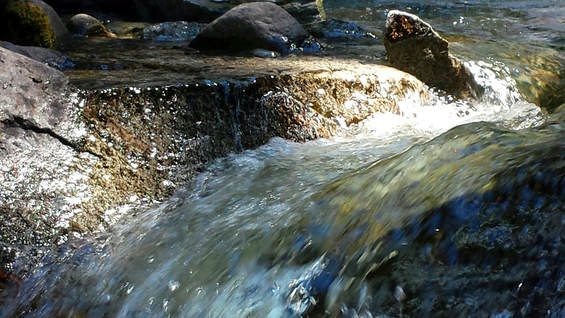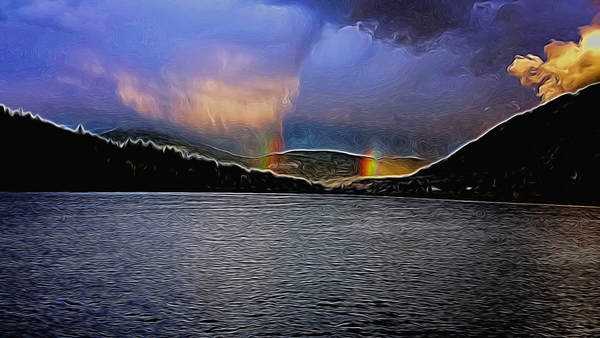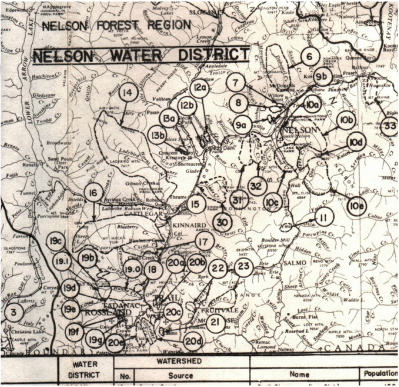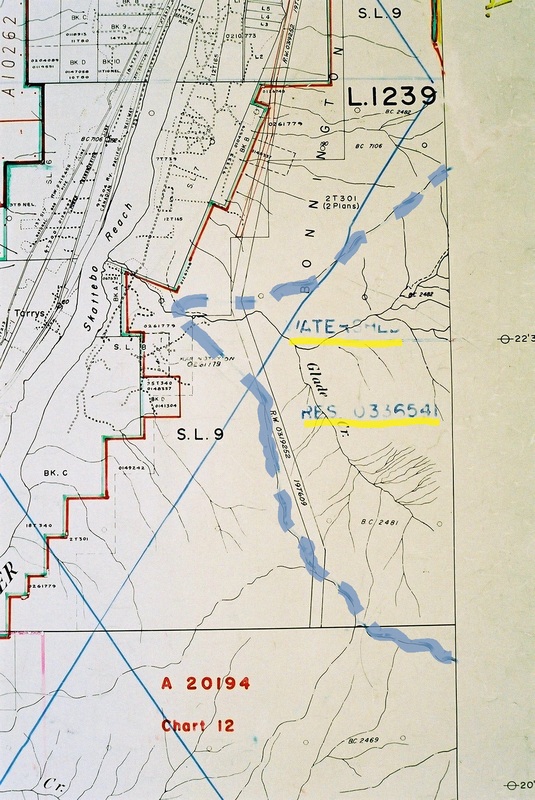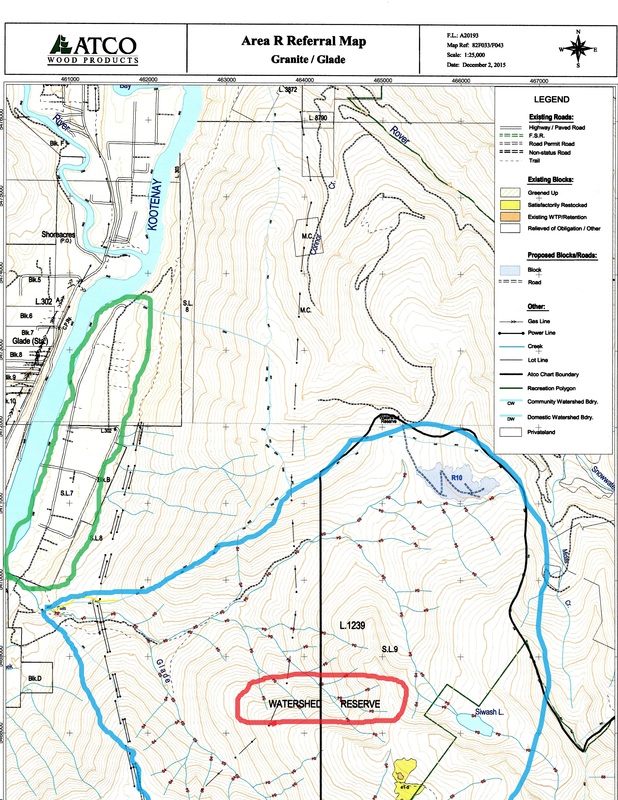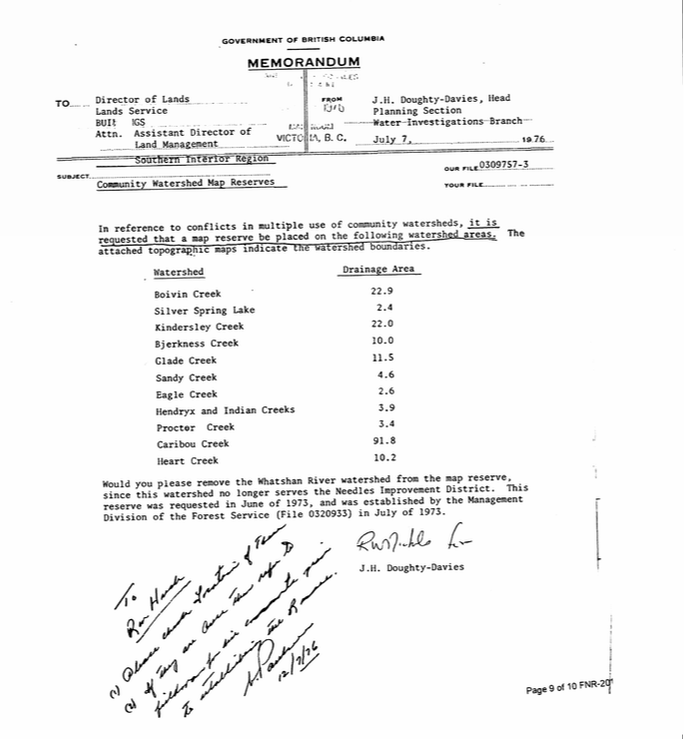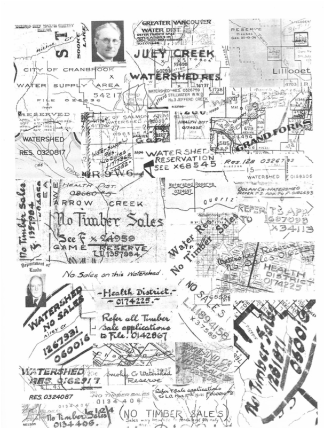Watershed Reserves
"...the best — and often the cheapest — way to maintain clean drinking water, healthy aquatic ecosystems...is to not allow them to be compromised in the first place."
http://www.water-matters.org/story/361
http://www.water-matters.org/story/361
Watershed Reserve
Excerpt below from W. Koop's book From Wisdom to Tyranny: A History of British Columbia's Drinking Watershed Reserves, 2006, p25)
The definition of a “Watershed Reserve” is quite simple and straightforward. It is exactly what it sounds like: a defined, demarcated physical area set aside through legislation and policy for a given purpose. A Watershed Reserve is to be protected in its natural state for drinking, domestic and irrigation water purposes... Such reserves were (and continue to be) created under powers vested in British Columbia’s Land Act legislation. Provincial Parks and Ecological Reserves are other types of Land Act “reserves.”
Government agencies have also provided recent definitions of what a “Reserve” is. In 1988, for instance, the federal government published a document called Forest Inventory Terms in Canada, which was approved by the Canadian Forest Ministers’ Committee. According to the booklet (p70), “Reserved (forest land)” is defined as “Forest land that, by law or policy, is not available for the harvesting of forest crops”. (Emphasis added)
Reclaiming Protected Watershed Status:
Over half of the population of BC has reclaimed their right to protect their watersheds from industry. Why can't we?
Metro Vancouver (formerly the Greater Vancouver Regional District) receives its drinking water from three protected watersheds: Seymour, Capilano, and Coquitlam. Including off-catchment lands, the total area is approximately 58,000Ha. No residential, industrial, recreational, or agricultural activities occur in these watersheds, thus reducing the risk of source water contamination. Glade Creek Watershed is 2977Ha, only about 5% of the size of the Vancouver watershed Reserve.
See HERE for a PDF created by the BC Tap Water Alliance on the Greater Vancouver Watershed Reserve. Greater Victoria also receives water from a protected watershed. Between the 2 areas: Vancouver and Victoria, 59% of the BC population are fortunate enough to get water from an area protected for the sole purpose of providing clean, safe water to 2.5 million people.
Over half of the population of BC has reclaimed their right to protect their watersheds from industry. Why can't we?
Metro Vancouver (formerly the Greater Vancouver Regional District) receives its drinking water from three protected watersheds: Seymour, Capilano, and Coquitlam. Including off-catchment lands, the total area is approximately 58,000Ha. No residential, industrial, recreational, or agricultural activities occur in these watersheds, thus reducing the risk of source water contamination. Glade Creek Watershed is 2977Ha, only about 5% of the size of the Vancouver watershed Reserve.
See HERE for a PDF created by the BC Tap Water Alliance on the Greater Vancouver Watershed Reserve. Greater Victoria also receives water from a protected watershed. Between the 2 areas: Vancouver and Victoria, 59% of the BC population are fortunate enough to get water from an area protected for the sole purpose of providing clean, safe water to 2.5 million people.
Glade Watershed Reserve:
Through Freedom of Information, Glade Watershed Protection Committee attained documents regarding the tenure status of Glade as a Community Watershed Map Reserve. Glade Creek Watershed is listed clearly on various maps with the designation of 'watershed reserve'. Below are 3 maps that show Glade's status as a Watershed Map Reserve. #1 is the oldest, #2 is from the 70s, and #3 is from 2015 (ATCO).
Through Freedom of Information, Glade Watershed Protection Committee attained documents regarding the tenure status of Glade as a Community Watershed Map Reserve. Glade Creek Watershed is listed clearly on various maps with the designation of 'watershed reserve'. Below are 3 maps that show Glade's status as a Watershed Map Reserve. #1 is the oldest, #2 is from the 70s, and #3 is from 2015 (ATCO).
|
Glade is shown in government documents as being a Watershed Map Reserve, like this one from 1976, from the Water Investigations Branch to the Director of Lands.
|
Second Preliminary Report on Glade Creek Watershed Reserve
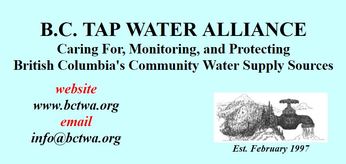
On August 30, 2016 Will Koop, coordinator at the BC Tap Water Alliance completed a 74 page preliminary report on the Glade Creek Watershed Reserve.
It has since been replaced by a May 2017 publication of 141 pages 'The Second Preliminary Report'. This detailed document traces the history of Glade Creek Watershed Reserve up to what is currently happening. There are historical maps, current maps, and discussions of other watershed reserves in the Kootenays.
You can find the report on the BC Tap Water Alliance website at: www.bctwa.org/
It has since been replaced by a May 2017 publication of 141 pages 'The Second Preliminary Report'. This detailed document traces the history of Glade Creek Watershed Reserve up to what is currently happening. There are historical maps, current maps, and discussions of other watershed reserves in the Kootenays.
You can find the report on the BC Tap Water Alliance website at: www.bctwa.org/
Or you can download it here: (24.9MB)
| glade_reserve_-_may_1_2017_2nd_preliminary_report._wkoop.pdf |
Or download in two smaller parts.
Part 1 (14.3MB)
Part 1 (14.3MB)
| glade_reserve_-_may_1_2017_2nd_prelim.report.kooppart1.pdf |
and Part 2 (11.1MB)
| glade_reserve_-_may_1_2017_2nd_prelim.report.kooppart2.pdf |
'Misnomer: a wrong or inaccurate name or designation...'
In an April 2016 meeting, the ATCO forestry manager stated that the term 'watershed reserve' is a “misnomer” (a wrong or inaccurate name or designation). In the forestry manager’s email (April 2016) 'watershed reserves' were described as: The term 'Watershed Reserve' on the mapping is a very early mapping terminology which simply denotes a Community Watershed. The word Reserve in this term can easily be mistaken for an area where there is no logging.
The comments about the watershed reserve being a 'misnomer' from both lumber company representatives sounds exactly like this:
The comments about the watershed reserve being a 'misnomer' from both lumber company representatives sounds exactly like this:
Furthermore, if you talk to government foresters about the fact that drinking watershed sources should not rightfully be part of the Allowable Annual Cut or the operable timber harvesting land base (what is now generally referred to as “the Working Forest”), they will simply tell you, “that is your opinion.”
However, we encourage the public to take heart and not be fooled by these remarks, which are part of a long and shameful tradition within the Ministry of Forests to eradicate the protection of drinking water sources. Such comments are meant to misdirect the public and persuade it to forget that there ever were such things as Reserves, protected by legislation and dedicated solely to the “single use” of water production. (W. Koop: From Wisdom to Tyranny, 2006 p17)
In their 'Summary of Public Concerns' (April 2017) Kalesnikoff Lumber Company offered the following response from the Kootenay Boundary Regional Land Authorizations Section Head, (FLNRO) S.Dailey:
The term watershed reserve is a Lands Act term which is clear from the following explanation. To my knowledge, the term ‘Watershed Reserve’ would only apply to historical Land Act Reserves that were established over Watershed areas.
This is exactly what could be maintained: That Glade was a Watershed Reserve applied during historical Land Acts and established over our Watershed area, and still valid today.
From "Single Use" to "Multi-Use" to "Integrated Management":
A policy of “single use” of such watersheds (for water production only) had long dominated both governmental and public thinking. The forest industry, however, considered “single use” a threat and an irritant, and gradually insinuated an alternative model, one of “multiple use”—later polished under the banner of “integrated resource management”—thus eroding and, eventually, eradicating the protected status of municipal and community drinking water sources. (W. Koop: From Wisdom to Tyranny, 2006 p8)
In the late 60s the logging companies began to look towards the great, old wood that grew in the watersheds: timber that they could access cheaply with high return, as they are doing today.
The Ministry of Forests was largely responsible for changing the “single use” approach to community watersheds into “multiple use” and made claims that logging and community water could exist on the same plane and in fact, should do that. And then water, a right claimed by the people, slid down the list of priorities when stacked up against the rights claimed by industry.
At one time, the Ministry of Environment and the Ministry of Health were strong advocates on the protection of community watersheds. They now tow the line on the Ministry of Forests’ multiple use policy, as we can see from these examples:
The Ministry of Forests was largely responsible for changing the “single use” approach to community watersheds into “multiple use” and made claims that logging and community water could exist on the same plane and in fact, should do that. And then water, a right claimed by the people, slid down the list of priorities when stacked up against the rights claimed by industry.
At one time, the Ministry of Environment and the Ministry of Health were strong advocates on the protection of community watersheds. They now tow the line on the Ministry of Forests’ multiple use policy, as we can see from these examples:
- The Minister of Environment neatly sidesteps any involvement in protecting watersheds by stating in a letter to the Glade Watershed Protection Committee (M. Polak. July 2016): "As you are likely aware, the topic of logging falls under the jurisdiction of the Ministry of Forests, Lands and Natural Resource Operations."
- Even though The Minister also maintains in the same letter that "protecting water resources in the province is of the utmost importance. Our current laws protect many aspects of the ways we use water for recreation, drinking and transportation. Our laws can also protect ecological values, such as healthy streams, lakes and wetlands."
- Even though The Minister also maintains in the same letter that "protecting water resources in the province is of the utmost importance. Our current laws protect many aspects of the ways we use water for recreation, drinking and transportation. Our laws can also protect ecological values, such as healthy streams, lakes and wetlands."
- [2002, a report by the BC Tap Water Alliance Doctoring our Water: From a Policy of Protection to a Policy of Submission (pg 81, Provincial Health Officer's Report, 2001)] In 2001, the Provincial Health Officer was less subtle. He said: "One of the most contentious issues is logging in watersheds. B.C.’s economy has been built through forestry, and it is still one of the larger employers in the province. From the broader public health perspective, British Columbia should not focus solely on the quality of our drinking water as the most important factor that imparts good health to its citizens...It is neither feasible nor necessary to ban all logging in watersheds that feed drinking water supplies."
